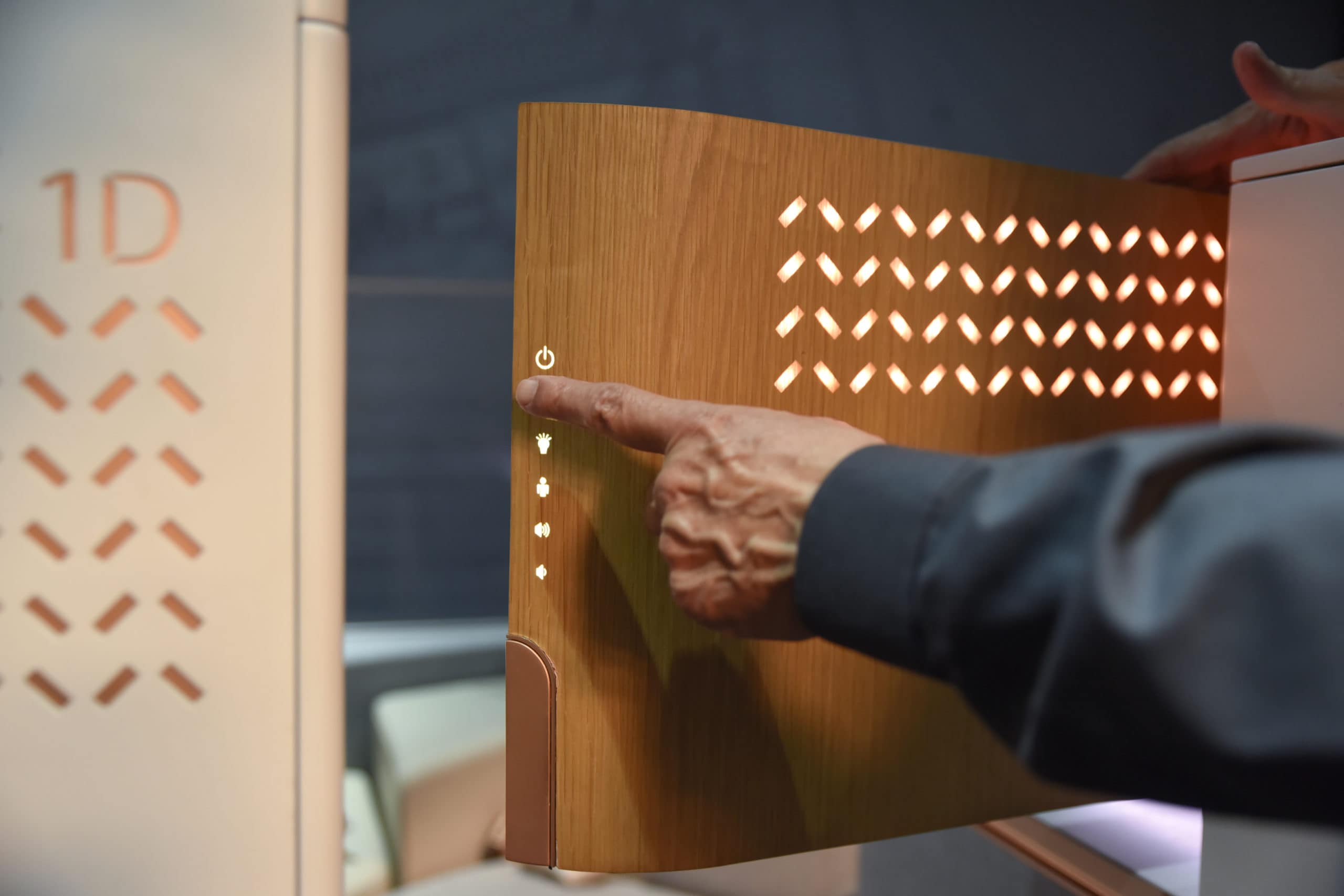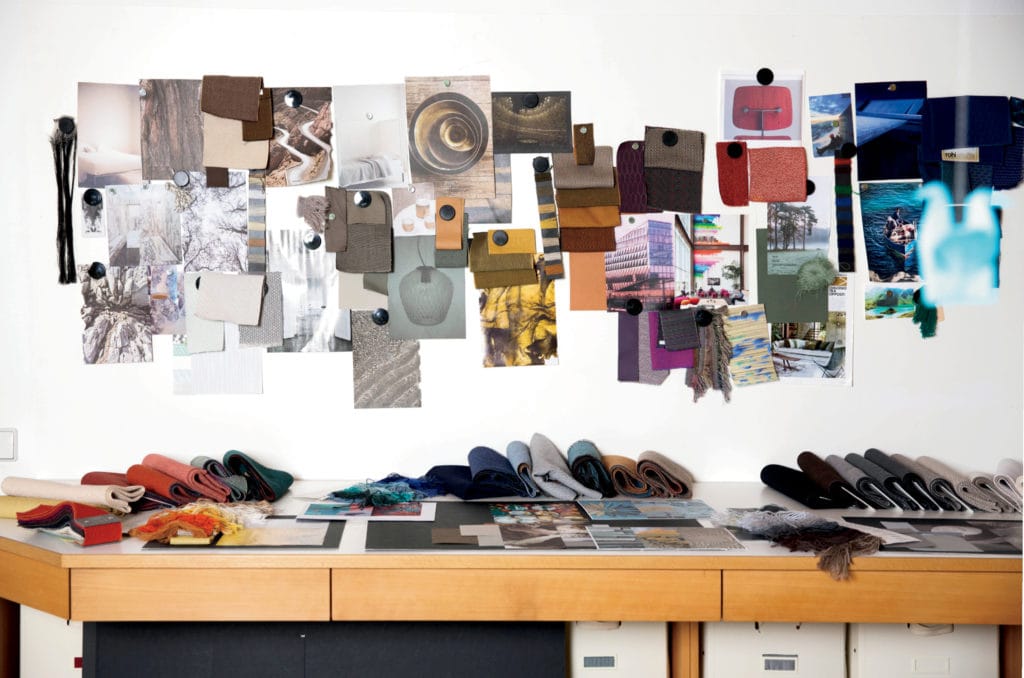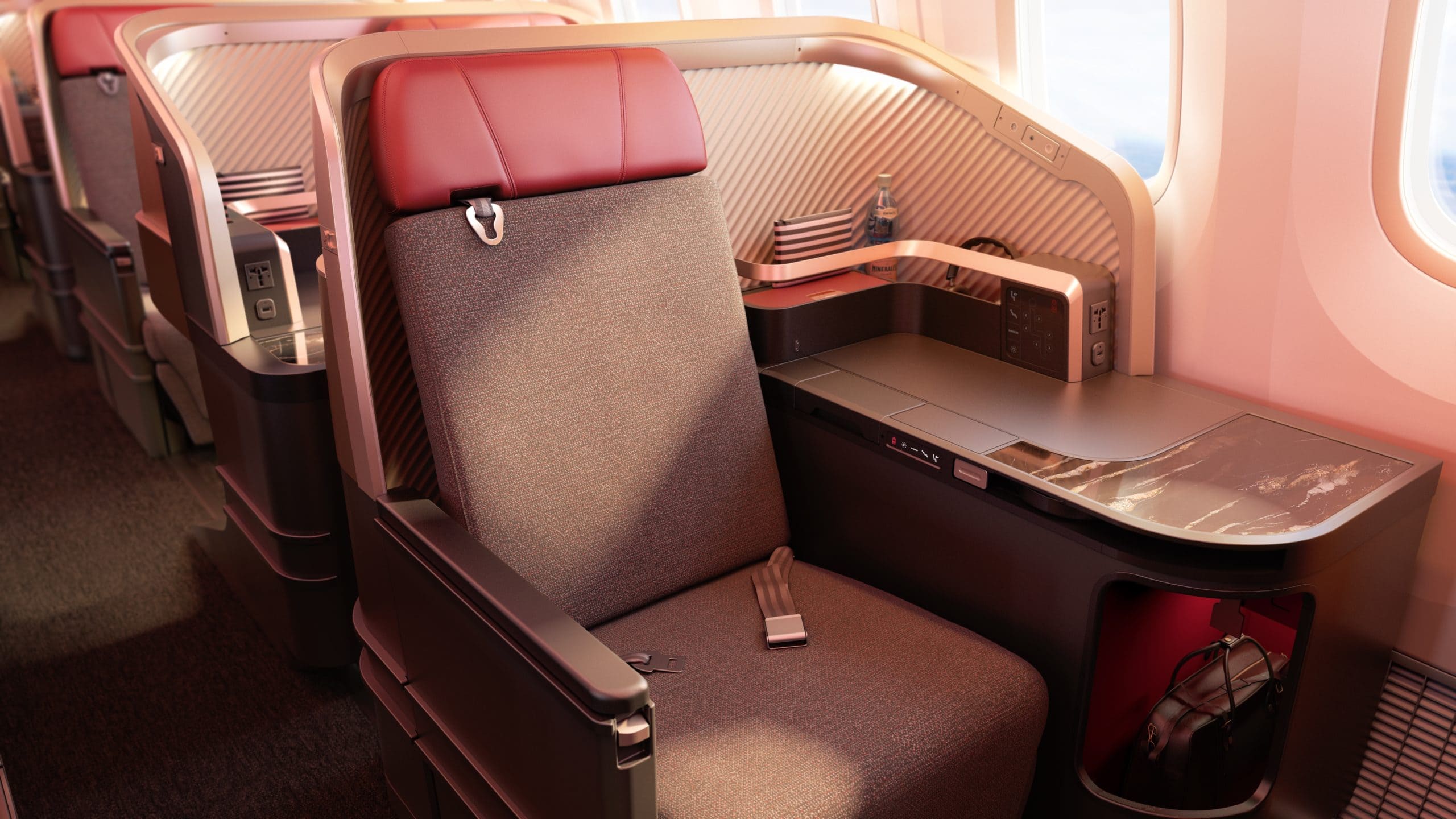Technology has taken a domestic turn, and now aircraft interior designers are weaving this softer edge into the cabin experience, too.
Sprawled across the ground floor of Rossana Orlandi’s eponymous gallery in Milan last April was a model for how technology can meld, unobtrusively, into the domestic. The exhibition, entitled Softwear, was by Google and curated by Dutch trend forecaster Lidewij Edelkoort, who had coined the titular terminology two decades prior, giving shape to a reality that, at the time, was only just beginning: the convergence of technology and daily life.
Softwear was Google’s first foray into the annual Salone del Mobile, a week-long furniture and design fair that draws crowds by the hundreds of thousands from around the world and across industries, such as architecture, fashion and even aviation. Among those who descended on the Italian metropolis were a small team from tangerine, a design consultancy known for its work on British Airways’ iconic yin-yang business-class cabin and, more recently, interior designs for Virgin Australia, Cathay Pacific and Gulf Air.
“We are noticing that the pull of technology no longer means things have to be hard or less sumptuous.” €” Emma Partridge, tangerine
“We attend these types of shows not to identify trends – these are of no use in the aircraft world where designs have a longer shelf life – but to be aware of how tastes and expectations beyond the cabin are evolving,” says Emma Partridge, head of Color, Material and Finish (CMF) at tangerine. The firm’s designers reported back from Milan on Google’s domestic turn, as well as on Sony’s Hidden Senses installation, which showcased how hidden sensor technology could animate ordinary objects. “What we are noticing is that the pull of technology no longer means things have to be hard or less sumptuous,” Partridge says.
Maria Kafel-Bentkowska, CMF project head at PriestmanGoode, herself a regular attendee of shows like Salone del Mobile, says aircraft interiors shouldn’t be approached by designers as stand-alone environments, but as extensions of a passenger’s lifestyle. “Our homes are becoming more minimal in design and in content, with technology integrating and blending into surfaces,” she says. “Passengers are increasingly expecting that same understated domestic feel in the cabin, especially because the surfaces are so close to you.”
Hard Times Are Over
If the very companies responsible for replacing the tangible with the digital and thrusting sleek, shiny screens into our hands are now rethinking the visual and tactile characteristics of their technologies, so, too, should airlines, says Liliana Becerra, a professor, author and designer whose recent clients include Huawei, Sonos and Zodiac Aerospace (now Safran). “The current approach to CMF in commercial aviation is still very traditional and needs to be pushed forward in general, according to emerging consumer and technological trends,” she says.
Becerra points to self-driving cars, which transform the ride into an opportunity to perform activities other than driving, as a site for innovative CMF design. These still-nascent environments, what she calls “in-between spaces” or “mobile living rooms,” use calmer, more muted colors, textures and materials, as well as smarter surfaces. “Here, the approach to interior design is very different than the one traditionally used for commercial aviation interiors,” she says. “We can expect a similarly subtle approach to commercial aviation interiors moving forward.”

We’ve already begun to see flashy, in-your-face technology take a back seat in aircraft interiors with product launches for more discreet technologies. Take inductive charging and smart surfaces with embedded circuitry, for example. First integrations of Astronics Advanced Electronic Systems’ wireless charging module for Qi-enabled mobile devices are slated for rollout on aircraft in 2019. And, last September at APEX EXPO, Panasonic Avionics unveiled a suite of wellness features incorporated into a Collins Aerospace premium business-class seat, complete with a touch-sensitive passenger interface panel integrated into a backlit, wood-like laminate.
Although by no means a new consideration for designers, lighting is increasingly being conceptualized in tandem with CMF applications, as new materials open up greater possibilities. “Materials and lighting are now being developed together, as complementary elements that work in symbiosis to create a coherent look,” Kafel-Bentkowska says, pointing to Sekisui’s product Kydex Lumina, a thermoplastic material that selectively filters light into silhouettes, which is shortlisted for this year’s Crystal Cabin Award.
Remarking on the same welcome evolution in lighting, Rachael Gartside, a designer at factorydesign, mentions new options with solid materials, such as Corian, that can be routed to diffuse light in any pattern, as well as laminates, such as those from Schneller, whose visible patterns change according to the color of light in its surroundings. “I see a lot of potential in this area to add subtle elements that enrich the overall feel of quality and consideration in the cabin,” she says.
“We are seeing a wide-ranging desire for more coziness and softness as a counterpart to a world getting always more technical and hard.” €” Katrin Hielle-Dahm, rohi
As efforts to temper tech multiply, so too does interior design seem to adopt softer, more inviting colors and textures more generally – good news for a company like rohi, which has specialized in premium wool fabrics for the past 85 years. “We are seeing a wide-ranging desire for more coziness and softness as a counterpart to a world getting always more technical and hard,” says Katrin Hielle-Dahm, managing director and head of Design at rohi.
A furniture fabric maker at its roots, the company today counts Air France, Air Canada and Qatar Airways among its airline customers, claiming to be “probably the only established aerospace supplier with a profound understanding of the domestic furniture sector,” Hielle-Dahm says. With warm, voluminous materials replacing synthetic fibers and leathers on the ground, Hielle-Dahm says rohi has the know-how to replicate the “feel at home” look in the air with lighter-weight variants.
Like rohi, Lantal draws inspiration from adjacent industries, accumulating these into a yearly trend report and corresponding Conceptual Forecast collection. Its most recent installment includes a “Fairytale” line highlighting imperfection, soft lines and organic patterns, as well as one entitled “Genuine Matter,” which embraces a pared-down aesthetic with emphasis on quality and rawness.

Honest Materials and Emotions
With news of data breaches and surveillance scandals, trust in big tech is faltering – we even have a word for it: “techlash.” The portmanteau for “technology” and “backlash” made its way into Oxford Dictionaries’ shortlist for the 2018 Word of the Year, and with it comes a growing demand among consumers for transparency.
Of course, this distaste for being duped is basic human psychology, and it applies to CMF in aircraft interiors, too, says Dominique Raye, manager of Color and Trim, at Style&Design, a design firm expected to announce its first airline partner later this year. “The last thing you want to do is generate feelings of deception. If from far a material looks real, but from close the sound of it, the touch of it and the temperature of it is fake – let’s say it’s clearly plastic – passengers will feel tricked, and your efforts will be lost. At least with a natural material, whether they like it or not, they are free to feel something real,” she says.
Laurent Stritter, who recently joined the firm as VP Aerospace – after 22 years at Zodiac Aerospace – to help it expand into the aviation vertical, agrees. “Authenticity is very important in CMF. So we thought, ‘Hey, why don’t we try to find real materials that we could insert inside a composite shell,'” he says. “We found this company that basically peels thin layers out of big chunks of rocks – it would have the same texture as a real stone but without most of the weight. We believe that’s something that could bring a lot of value.”
PriestmanGoode opted for a similar solution for the granite tabletops in the newly redesigned LATAM Airlines business-class cabin. The cocktail tables are made from a material developed by Austrian company F/LIST: a thin layer of granite with a carbon-fiber backing. “With all the developments in processing materials and treatment technology, we’re looking at how these can be applied to natural materials that could be used on board,” Kafel-Bentkowska says. “While many companies try to imitate nature, we believe real, honest materials also have their place within interiors.”

Raw materials aren’t just essential to the final product; they need to be present in the development phase as well, tangerine’s Partridge says. “You simply cannot rely on digital imagery – something that perhaps the younger, less experienced generation of designers resort to too much. You need to have the materials in front of you. You need to touch them.” Partridge spends a lot of her time doing exactly that: visiting mills, labs and studios to co-create with suppliers in real time. “That’s what I enjoy doing most, and that’s how you get the best result, whether it is for woven textiles or laminates. And most suppliers are actually really receptive to that.”
In the case of the Gulf Air redesign, being hands-on took on another meaning, with Partridge and her team experiencing Bahraini culture and craftsmanship firsthand before arriving at the rich brown leather details, textured upholstery and metallic threads that would ultimately characterize the airline’s business-class cabin. “As designers, we arrive at a lot of this stuff intuitively, but being in Bahrain did help to reassure ourselves and the client of our direction, and helped us make some meaningful tweaks, too,” Partridge says. “We fully immersed ourselves, by going to the museum of art, experiencing the restaurants and hotels of Bahrain, and visiting local markets and any new architecture – by seeing and feeling the environment.”
Experiencing a brand, like a place, isn’t just about seeing – it’s about touching, feeling, Kafel-Bentkowska says, adding that this is why PriestmanGoode specializes in developing customized materials for brands, and not just colors. “A brand having a visual language as well as a tactile one is increasingly important as we become more and more aware and educated about our surroundings,” she says. As these surroundings begin to prioritize technologies with haptic and gestural interfaces, consumers can expect new materials and surfaces that allow for an even more intimate, embodied understanding of an airline’s brand. And with it a whole new meaning to that once elusive personal touch.
“Touching, Feeling” was originally published in the 9.2 April/May issue of APEX Experience magazine.


